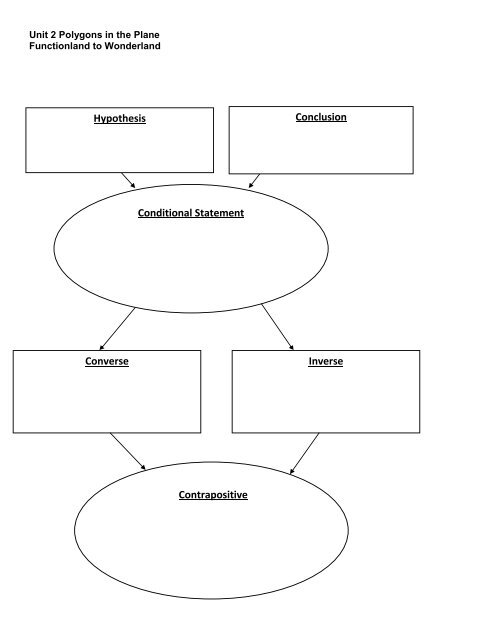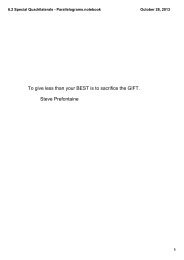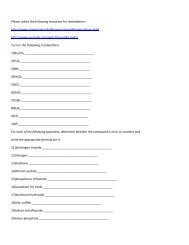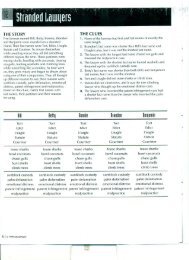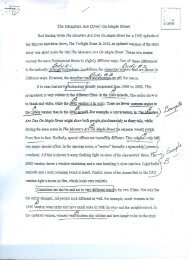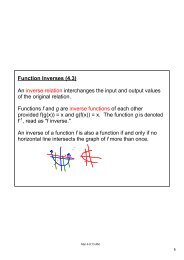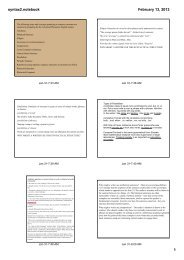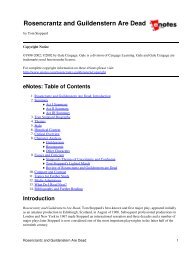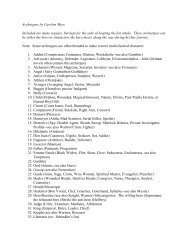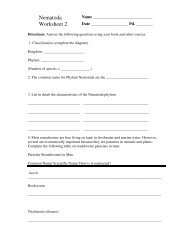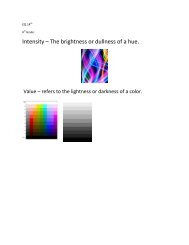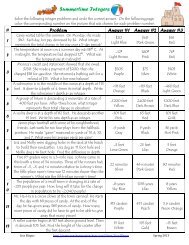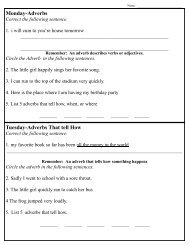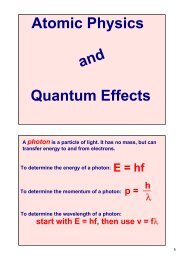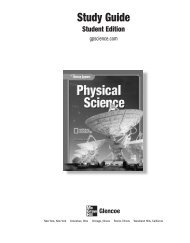Conditional Statement Converse Inverse Contrapositive Hypothesis ...
Conditional Statement Converse Inverse Contrapositive Hypothesis ...
Conditional Statement Converse Inverse Contrapositive Hypothesis ...
You also want an ePaper? Increase the reach of your titles
YUMPU automatically turns print PDFs into web optimized ePapers that Google loves.
Unit 2 Polygons in the Plane<br />
Functionland to Wonderland<br />
<strong>Hypothesis</strong><br />
<strong>Converse</strong><br />
<strong>Conditional</strong> <strong>Statement</strong><br />
<strong>Contrapositive</strong><br />
Conclusion<br />
<strong>Inverse</strong>
Write the two statements that make up this definition: A right angle has measure 90º.<br />
Example:<br />
<strong>Conditional</strong>: If an angle is a right angle, then its measure is 90º.<br />
<strong>Converse</strong>: If the measure of an angle is 90º, then it is a right angle.<br />
On your own: Find the converse, inverse, and contrapositive of each statement.<br />
<strong>Conditional</strong>: If today is Friday, then it is a weekday.<br />
<strong>Converse</strong>:<br />
<strong>Conditional</strong>: If today is Friday, then it is a weekday.<br />
<strong>Inverse</strong>:<br />
negate negate<br />
<strong>Conditional</strong>: If today is Friday, then it is a weekday.<br />
<strong>Contrapositive</strong>:<br />
negate both
For each statement, write (a) the converse, (b) the inverse, and (c) the contrapositive.<br />
1. If a triangle is a right triangle, then it has a 90° angle.<br />
(a)<br />
(b)<br />
(c)<br />
2. If a quadrilateral has exactly two congruent sides, then it is not a rhombus.<br />
(a)<br />
(b)<br />
(c)<br />
3. If two segments are congruent, then they have the same length.<br />
(a)<br />
(b)<br />
(c)<br />
4. If you do not work, you will not get paid.<br />
(a)<br />
(b)<br />
(c)<br />
5. If a polygon is a pentagon, then the sum of the measures of its angles is 540.<br />
(a)<br />
(b)<br />
(c)
q p<br />
~q ~p<br />
Using Symbols…<br />
p q<br />
~p ~q<br />
p q
Unit 2 Polygons in the Plane<br />
Functionland to Wonderland<br />
A statement is a sentence that is either true or false, but not both.<br />
A conditional statement is a statement that can be expressed in “if…then…” form.<br />
Near the beginning of the passage from Lewis Carroll’s Alice’s Adventures in Wonderland, Chapter VII, the<br />
Hatter responds to Alice that she might as well say that “I see what I eat” means the same thing as “I eat what I<br />
see.”<br />
Let’s express each of the Hatter’s example sentences in “if … then” form.<br />
“I see what I eat” has the same meaning as the conditional statement “If I eat a thing, then I see it.”<br />
On the other hand, “I eat what I see” has the same meaning as the conditional statement “If I see a thing, then I<br />
eat it.”<br />
1. Express each of the following statements from the Mad Tea Party in “if … then” form.<br />
a. I like what I get. ____________________________________________________________________<br />
b. I breathe when I sleep. _______________________________________________________________<br />
2. We use specific vocabulary to refer to the parts of a conditional statement written in “if … then …” form.<br />
The hypothesis of a conditional statement is the statement that follows the word “if.”<br />
So, for the conditional statement “If I eat a thing, then I see it,” the hypothesis is the statement “I eat a<br />
thing.” Note that the hypothesis does not include the word “if” because the hypothesis is the statement that<br />
occurs after the “if.”<br />
Give the hypothesis for each of the conditionals from # 1, parts a and b.<br />
1 a. ______________________________________<br />
1 b. ______________________________________<br />
3. The conclusion of a conditional statement is the statement that follows the word “then.”<br />
So, for the conditional statement “If I eat a thing, then I see it,” the conclusion is the statement “I see it.”<br />
Note that the conclusion does not include the word “then” because the conclusion is the statement that<br />
occurs after the word “then.”<br />
Give the conclusion for each of the conditionals from # 1, parts a and b.<br />
1 a. ______________________________________<br />
1 b. ______________________________________
Now, we want to compare the hypotheses (note that the word “hypotheses” is the plural of the word<br />
“hypothesis”) and conclusions of the Hatter’s conditionals. To help us see the key relationship between his two<br />
conditional statements, we replace the pronoun “it” with the noun “thing.” This replacement doesn’t change the<br />
meaning. As far as the grammar is concerned, we have a repetitious sentence. However, this repetition helps us<br />
analyze the relationship between hypotheses and conclusions.<br />
4. a. List the hypothesis and conclusion for the revised version of each of the Hatter’s conditional<br />
statements given below.<br />
<strong>Hypothesis</strong> Conclusion<br />
If I eat a thing, then I see the thing. ___________ _____________ _ _______________________<br />
If I see a thing, then I eat the thing. ___________ _____________ _ _______________________<br />
b. Explain how the Hatter’s two conditional statements are related.<br />
5. There is a term for the new statement obtained by exchanging the hypothesis and conclusion in a conditional<br />
statement. This new statement is called the converse of the first.<br />
a. Write the converse of each of the conditional statements in #1, parts a and b, using “if … then …” form.<br />
1 a. ______________________________________<br />
1 b. ______________________________________<br />
b. What happens when you form the converse of each of the conditional statements above?<br />
6. The March Hare, Hatter, and Dormouse did not use “if … then” form when they stated their<br />
conditionals.<br />
Write the converse for each conditional statement below without using “if … then” form.<br />
<strong>Conditional</strong>: I breathe when I sleep. <strong>Converse</strong>: ________________________________<br />
<strong>Conditional</strong>: I like what I get. <strong>Converse</strong>: ________________________________<br />
<strong>Conditional</strong>: I see what I eat. <strong>Converse</strong>: ________________________________<br />
<strong>Conditional</strong>: I say what I mean. <strong>Converse</strong>: ________________________________
7. a. What is the relationship between breathing and sleeping expressed in the conditional statement “I<br />
breathe when I sleep?” If you make this statement is it true or false?<br />
b. What is the relationship between breathing and sleeping expressed by the conditional statement “I sleep<br />
when I breathe”? If you make this statement, is it true or false?<br />
A compound statement is a new statement formed by putting two or more statements together to form a new<br />
statement.<br />
There are several specific ways to combine statements to create a compound statement. Compound statements<br />
formed using “and” and “or” are important in the study of probability. In this task, we are focusing on<br />
compound statements created using the “if … then …” form.<br />
Definition: If p and q are statements, then the statement “if p, then q” is the conditional statement, or<br />
implication, with hypothesis p and conclusion q.<br />
We call the variables used above, statement, or propositional, variables.<br />
We would like to find a general conclusion about the logical relationship between a conditional statement and<br />
its converse. In other words, we are looking for a relationship that is true no matter what particular statements<br />
we substitute for the statement variables p and q. That’s why we need to see more examples.<br />
Whether a statement is ture or false is called the truth value.<br />
Our goal for this item is to decide whether there is a general relationship between the truth value of a<br />
conditional statement and the truth value of its converse. Any particular conditional statement can be true or<br />
false, so we need to consider examples for both cases.<br />
Refer back to your homework (1-5) , examine the truth values of the conditional statements and its converse.<br />
8. a. Complete the following sentence to make a true statement. Explain your reasoning. Is your answer<br />
choice consistent with all of the examples of converse from your homework (1-5)?<br />
Multiple choice: The converse of a true conditional statement is ____.<br />
A) always also true<br />
B) always false<br />
C) sometimes true and sometimes false because whether the converse is true or false does not depend on<br />
whether the original statement is true or false.
. Complete the following sentence to make a true statement. Explain your reasoning. Is your answer<br />
choice consistent with all of the examples of converse from your homework (1-5)?<br />
Multiple choice: The converse of a false conditional statement is ____.<br />
A) always also false<br />
B) always true<br />
C) sometimes true and sometimes false because whether the converse is true or false does not depend on<br />
whether the original statement is true or false.<br />
Whenever we talk about statements in general, without having a particular example in mind, it is useful to talk<br />
about the propositional form of the statement.<br />
For the propositional form “if p, then q”, the converse propositional form is “if q, then p.”<br />
If two propositional forms result in statements with the same truth value for all possible cases of substituting<br />
statements for the propositional variables, we say that the forms are logically equivalent.<br />
If there exist statements that can be substituted into the propositional forms so that the resulting statements have<br />
different truth values, we say that the propositional forms are not logically equivalent<br />
c. Consider your answers to parts a and b, and decide how to complete the following statement to make<br />
it true. Justify your choice.<br />
The converse propositional form “if q, then p” is/is not (choose one) logically equivalent to the<br />
conditional statement “if p, then q.”<br />
d. Multiple choice: If you learn a new mathematical fact in the form “if p, then q”, what can you<br />
immediately conclude, without any additional information, about the truth value of the converse?<br />
A) no conclusion because the converse is not logically equivalent<br />
B) conclude that the converse is true<br />
C) conclude that the converse is false<br />
e. In the opening of the passage from Alice in Wonderland, when Alice hastily replied<br />
"I do, at least -- at least I mean what I say -- that's the same thing, you know."<br />
What statements did Alice think were logically equivalent?<br />
What was the Hatter saying about the equivalence of these statements when he replied to Alice by<br />
saying "Not the same thing a bit!"?<br />
There are two other important propositional forms related to any given conditional statement. We introduce<br />
these by exploring other inhabitants of the land of functions.
In logic, we form the negation of a statement p by forming the statement “It is not true that p.” For<br />
convenience, we use “not p” to refer to the negation of the statement p.<br />
In the following examples, notice that when we translate “not p” into English, we can usually state the<br />
negation in a more direct way.<br />
• when p represents the statement “The input of the function g is –3,”<br />
o then “not p” represents “The input of the function g is not –3”, and<br />
• when, as above, q represents the statement “The output of the function g is not 5,”<br />
o then “not q” represents “The output of the function g is not not 5,” or more simply<br />
“The output of the function g is 5.”<br />
A statement of the form “If not p, then not q” is called the inverse of the conditional statement<br />
“if p, then q.” Note that the inverse is formed by negating the hypothesis and conclusion of a conditional<br />
statement.<br />
9. a. Consider the results in your homework (1-5), and then decide how to complete the following statement<br />
to make it true. Justify your choice.<br />
The inverse propositional form “if not p, then not q” is/is not (choose one) logically equivalent to the<br />
conditional statement “if p, then q.”<br />
b. Multiple choice: If you learn a new mathematical result in the form “if p, then q”, what can you<br />
immediately conclude, without any additional information, about the truth value of the inverse?<br />
A) no conclusion because the inverse is not logically equivalent<br />
B) conclude that the inverse is true<br />
C) conclude that the inverse is false<br />
A statement of the form “If not q, then not p” is called the contrapositive of the conditional statement “if p,<br />
then q.” Note that the contrapositive is formed by both negating and exchanging the hypothesis and conclusion.<br />
10. a. Consider your answers from your homework (1-5), and decide how to complete the following<br />
statement to make it true. Justify your choice.<br />
The propositional form “if p, then q” is/is not (choose one) logically equivalent to its<br />
contrapositive “if not q, then not p.”
. Multiple choice: If you learn a new mathematical result in the form “if p, then q,” what can you<br />
immediately conclude, without any additional information, about the truth value of the contrapositive?<br />
A) no conclusion because the contrapositive is not logically equivalent<br />
B) conclude that the contrapositive is true<br />
C) conclude that the contrapositive is false<br />
Summarizing the information about forming related conditional statements, we see that the conditional “if p,<br />
then q,” has three related conditional statements:<br />
converse: “if q, then p” (swaps the hypothesis/conclusion)<br />
inverse: “if not p, then not q” (negates the hypothesis/conclusion)<br />
contrapositive: “if not q, then not p” (negates hypothesis/conclusion, then swaps)<br />
Which, if any, of these is logically equivalent to the original conditional statement and always has the<br />
same truth value as the original?<br />
The absolute value function f and the functions g and h that you have worked with in this investigation are not<br />
linear. However, in your study of functions prior to Mathematics I, you have worked with many linear<br />
functions. We conclude this investigation with discussion about converse, inverse, and contrapositive using a<br />
linear function.<br />
11. Consider the linear function F which converts a temperature of c degrees Celsius to the equivalent<br />
temperature of F(c) degrees Fahrenheit. The formula is given by<br />
F(c) = 9<br />
5 c + 32, where c is a temperature in degrees Celsius.<br />
a. What is freezing cold in degrees Celsius? in degrees Fahrenheit? Verify that the formula for F<br />
converts correctly for freezing temperatures.<br />
b. What is boiling hot in degrees Celsius? in degrees Fahrenheit? Verify that the formula for F converts<br />
correctly for boiling hot temperatures.<br />
c. Draw the graph of F for values of c such that –100 ≤ c ≤ 400. What is the shape of the graph you<br />
drew? Is this the shape of the whole graph?
d. Verify that “if c = 25, then F(c) = 77” is true. What is the contrapositive of this statement? How do<br />
you know that the contrapositive is true without additional verification?<br />
e. What is the converse of “if c = 25, then F(c) = 77”? How can you use the formula for F to verify that<br />
the converse is true? What is the contrapositive of the converse? How do you know that this last<br />
statement is true without additional verification?<br />
There is a statement that combines a statement and its converse; it’s called biconditional.<br />
Definition: If p and q are statements, then the statement “p if and only if q” is called a biconditional statement<br />
and is logically equivalent to “if p, then q” and “if q, then p.”<br />
f. Write three true biconditional statements about values of the function F. Explain how you know that<br />
the statements are true.


